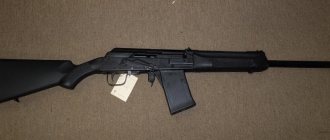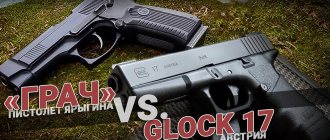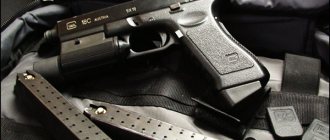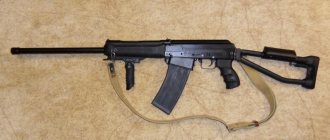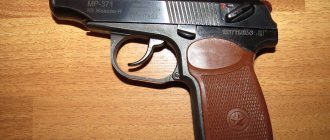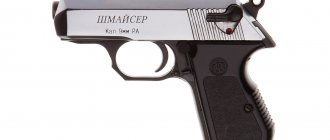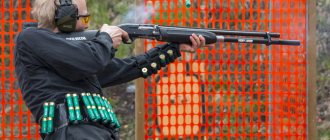Compared to the IZH-54 shotgun, known to many hunters, the IZH-26 horizontal rifle is less popular. The explanation for this fact is simple: a decade and a half was devoted to assembling IZH-54 guns, collecting about half a million copies, and IZH-26 (IZH-26E) guns were produced in quantities half as large as their predecessor. Naturally, the design of the 54th model gun is much more complex, which is confirmed by the number of samples produced, the cost of the product is higher, and hunters value it more. But IZH-26 has several undeniable advantages, which will be discussed below.
Description
For the manufacture of gun barrels, 50PA steel was used; a coupling connection was made in the breech, where the tubes were pressed in and locked with a special pin. The main barrel part is connected by straps. One of them, located in the upper part of the IZH-26 gun, is considered to be sighting. The bar located below consists of two parts. Between them, at the breech, a hinged post was soldered in, and the forend was attached to it. In the middle, a pair of screws fixes the swivel for attaching the belt.
Differences from IZH-54
The IZH-26 shotgun differs from the IZH-54 product in the modified design of the locking system. In the IZH-26 product, this matter has been simplified - the final (3rd) stage of locking is performed not with a Griner bolt, but by means of a bar moving along a groove in the upper part of the barrel box shield. At the moment of closing, it slides onto the small locking hook. The barrel hook protrudes above the breech section. The top locking bar, driven by the upper locking lever of the gun mechanism, secures the under-barrel hooks, as does the locking bar located below. The forend is increased in volume in width, the barrels cover more from the sides, which protects the shooter’s hand from possible burns. Unlike the IZH-54, the 26th model is distinguished by its elegant shape, improved finishing, good accuracy and sharpness of combat.
Based on the model of the existing system of the 54th model, the plant engineer changed the channel diameter of IZH-26. The gun began to be equipped with barrels, the diameter of which was 18.2 mm instead of 18.5 mm. This parameter is considered quite acceptable for the use of cartridges with paper sleeves. If you use metal cartridges, a discrepancy in size begins to appear, accuracy when shooting decreases by about twenty percent, and recoil increases.
Modernization and design of IZH-54
By the beginning of 1957, designer Pugachev had developed a new gun - the Izh-57. It would seem that the production of IZH-54 can be closed. However, everything turned out to be exactly the opposite; only 20,000 units of IZH-57 were produced, and even those became experimental. Each small batch had some kind of innovation. If buyers responded positively to it, then it was immediately installed on the IZH-54.
One of the most important improvements was the installation of new modern barrels and fire tubes. In addition, the strikers that were installed on the first models were considered imperfect, and they were replaced with strikers from the IZH-57 model.
The design of the gun had the following features:
- Barrels with a triple locking system provided the gun with incredible reliability. Even the use of cartridges with a powerful charge of gunpowder could not lead to damage to the gun;
- The strength of the receiver and the use of hardened parts of the gun mechanisms provided additional reliability;
- Thickened trunks;
- Common extractor for two barrels;
- Smooth and easy trigger release;
- A simple procedure for disassembling and reassembling the weapon.
All these parameters made the gun simply “indestructible”.
Design
The barrel of the IZH-26 is oxidized with “rusty varnish”. The coating is considered stable and safe, but low-tech. The gun block is covered with colored tracing paper. It looks beautiful, but after a few years it wears off, and in this regard it is absolutely no different from oxidation. However, abrasion of the coating does not lead to the appearance of rust, since the block is covered with a cemented metal layer, which gives it a unique attractiveness.
For the manufacture of the block, a low-carbon steel alloy was used, which is excellent for processing, but was considered of lower quality than 50A steel, which was used for the boxes of IZH-58 shotguns.
The IZH-26 stock has a pistol or straight shape and was made of walnut or beech wood.
Brand tubes, coated with a layer of chrome and decorating the block guards of guns, were intended to prevent burnout of the metal around the firing holes. This indirectly confirmed the weak resistance of steel 15 to the aggression of powder gas entering the primer sockets. This was considered most critical in the case of the use of “Tsentroboy” primers in brass sleeves, which were widely used by hunting fans at that time.
The barrels were adjusted to the box in IZH-26 twice - before heat treatment and after it was completed. The block of the IZH-26 gun was placed in a metal box filled with coal, pieces of leather and bones. After this, cementation was carried out for a long time (the top layer of metal was saturated with carbon), the heated pads were transferred to water, and contact with oxygen was completely excluded. This is the answer to the question to what extent the locking of the IZH-26 is weaker than that of the predecessor of this gun. The fact is that fastening with a Griner bolt slightly increases the rifle's service life. But when weapons are mass produced, it is difficult to perfectly fit each weapon, and the resource in this case is considered an individual indicator. It turns out that a perfectly assembled IZH-26 (until it shows signs of shatter) will have more rounds than a high-quality IZH-54.
The front trigger hook is spring-loaded, which allows you to protect your finger from impact at the moment of recoil during firing with the left barrel, when the rear trigger is pressed. This type of device is typical only for IZH-26 shotguns, which belong to the highest class. Automatic safeties simultaneously lock the release levers and hooks, while the simple Anson design has only hooks on the safety.
An ejector was introduced exclusively for export IZH-26E shotguns. It is fair to note that in our time, ejectors, like automatic fuses, have not found many fans. The IZH-26 version without an ejector was produced simultaneously with the IZH-26E, and a little later another modification of the IZH-26E-1S with one trigger was developed. But it did not enter mass production, and the main problem in this was the already established production of the IZH-58M model for 12 gauge. The power of the IZH-58M shot was similar, but the gun weighed much less and its cost was lower. In a word, the IZH-26 gun had all the qualities to attract the attention of the mass buyer.
In addition, the safety design provides for a smooth release of the trigger from the sear. For this purpose, at the moment the barrels are fully opened, the safety button is pulled forward with the thumb, the triggers are squeezed with the middle and index fingers, and the barrels are smoothly closed. Such actions should not be performed while ammunition is inserted into the chambers - there is a possibility of an accidental discharge.
IZH-26 shotguns were equipped with inertial firing pins with return springs, made separately from the hammers. They must be inserted from the side of the box flap, secured with chrome-plated fire tubes. In the event of a breakdown, there is no need to disassemble the IZH-26, as is necessary for any weapon that has pressed-in firing pins.
Changes in the design of IZH-54
Although the barrel, forend and butt of the IZH-54 were no different in appearance from the same components of the IZH-49, and the appearance was not very different from the appearance of its predecessor, most of the internal devices of the gun were thoroughly redesigned. The main changes were as follows:
- The Anson-Delay mechanism, which was used in the IZH-49, has become more modern and advanced. It received modified lower sears;
- The trigger indicators have been moved to the top of the block and are also lighter. Now it was not difficult to feel them with your finger in the dark;
- The firing pins were separated from the hammers;
- The safety mechanism has been redesigned, making it much easier to operate.
The new design turned out to be so successful that the gun was produced at the factory for 15 years. Although the basis of the gun was the German Sauer design, at its core it was a completely new hunting weapon.
Advantages and disadvantages
Numerous reviews confirm the reliability of the IZH-26 gun, which is not subject to the effects of time. The owners of this model assure that the IZH-26 gun is well assembled, “age-related” changes are visible only from the outside. All internal elements of the system remain perfect, there are no traces of rust. Users claim that the external defects of each gun are associated with insufficient care. There are old copies of IZH-26, in which the internal parts of the trigger are slightly touched by rust, but in general the system has retained normal performance.
Experts of this model are sure that it is difficult to reach the shat, even by shooting battery terminals, chopped nails or cast iron shot.
Specifications
A description of a weapon will be incomplete if you do not pay attention to its technical characteristics:
- barrel length – 730 mm;
- caliber IZH-26 – 12 mm;
- chamber length – 70 mm;
- weight of the IZH-26 gun – 3.3 kg;
- shooting accuracy: the right channel (half-choke), having a muzzle constriction of 0.5 mm - 55% accuracy, the left (choke) with a constriction of 0.1 cm - 65%.
- Produced from 1970 to 1975.
Disassembly and assembly
For ease of transportation, storage and maintenance of the IZH-26, it can be disassembled into two main parts - the receiver with the forend and the box with the stock. If times come when it is necessary to completely clean and lubricate the mechanism, or to repair something, the IZH-26 gun is completely disassembled. The algorithm of actions in this case is as follows:
- the fore-end latch is pulled towards itself in order to separate the latter from the gun;
- the locking plate, driven by hand, turns to the right until it stops, the barrels tilt down. Now they can be separated from the box with the stock;
- The screw holding the safety bracket is turned out. To separate it from the box, it will have to be turned in the direction opposite to the movement of the clock hand;
- the screws securing the base of the trigger mechanism are unscrewed. Two of them are located at the bottom, one is at the back, at the top there is a coupling, which is used to connect the shank of the box to the base located under the locking lever;
- using a screwdriver or a drift, applying gentle blows to the base through the windows under the receiver hooks, we separate the cocker from the box. It is necessary to work carefully so as not to lose the springs;
- We grab the neck of the stock with our left hand, and with our right hand we grab the box. Rocking it slightly, remove it from the stock using an up-and-forward movement. We will have access to the mechanism to inspect it, clean and lubricate it;
- We unscrew the cocking stops along with their axles and remove them from the box. It is recommended to immediately screw the mounting screws into place so as not to lose or mix them up;
- remove the sear. To do this, carefully knock out their axles with a drift, remove the drift, hold it, and take out the sears along with the springs;
- To remove the triggers, their axes are knocked out with a drift. You need to act with the bottom side of the box on a table or board so that the triggers do not fly out under the influence of the springs. The mainsprings will fly out of the box, after which it will be possible to remove the cocking indicators along with their springs and leads;
- To remove the safety button and the engine, the pin holding it is knocked out;
- to remove the locking plate spring, unscrew the threaded bushing holding it in the rear wall of the box;
- The locking mechanism is disassembled as follows: the box is placed with its bottom plane on the table, the screw in the head of the locking lever is turned out, a drift is inserted into the open threaded hole, with the help of which the lever axis is knocked down. We act carefully so as not to damage the thread. Having taken out the lever, ring and locking bar, remove the lower locking element (bar) from the box;
- from the mirror side of the box, unscrew the locking screws, use a special fork wrench to unscrew the bushings and remove the strikers.
History of creation
The history of the creation of IZH-26 dates back to 1970. It was then that Izhmash engineers began developing one of the most controversial modifications of the already famous IZH-54 smoothbore gun. The main goal was to simplify the barrel locking system: replace the Grimer bolt with a classic hook with a hinge. It was also necessary to reduce the weight of the weapon, as it was not suitable for use by teenagers and women.
The IZH-26 has a simplified barrel locking system
The first batch of guns that came off the assembly line caused a storm of indignation among buyers. Of course, it was typical for the Izhevsk Mechanical Plant to produce defective samples, but the IZH-26 had too many flaws. Despite the fact that the engineers tried to correct their mistake in future batches, people were already disappointed and lost all interest in the new gun. In 1975, its production stopped altogether.
Owner reviews about IZH-26
IZH-26 was lighter in comparison with IZH-54, on the basis of which it was developed. The design was simpler, the repairability was also much better: springs and strikers are most often changed, and in IZH-26 they can be changed very conveniently and quickly. By the way, the springs themselves have become more durable.
The balance and weight distribution of the gun, combined with its relatively small weight, made it more convenient to use, especially on long hunts on foot.
Among the disadvantages, it can be noted that the “engraving” on ordinary guns quickly wears off, that is, the gun quickly becomes shabby. But this cannot lead to the formation of rust.
Design
One of the main advantages of the IZH-26 over foreign analogues is its simple, but at the same time reliable design. For the manufacture of gun barrels, special carbon steel was used, which underwent repeated cold hardening procedures. Wooden parts were made only from hardwood materials (beech, birch, hazel). This weapon is not afraid of extreme weather conditions, and is also capable of withstanding shot energy of up to 200 J (although in practice this figure is almost never achieved).
The double-barreled shotgun IZH-26 is simple and reliable
Also, one of the main design features of the IZH-26 is its safety system, which was almost completely copied from the IZH-54 prototype. It consists of three levels:
- Automatic safety - activated when the barrels are cocked.
- Mechanical fuse - activated by directly pressing the button.
- The barrel locking mechanism prevents the gun from firing if the gun is not closed.
The latter system deserves special attention, because, compared to the prototype, it has undergone significant modernization. Firstly, the old and inconvenient make-up bolt was replaced with a simple hook with a hinge. Secondly, a new switch lever began to be located on the receiver, which made it possible, if necessary, to disable the barrel lock and release the cartridges. This system turned out to be simply irreplaceable for those cases when a cartridge misfires.
Hunting rifle switch lever
The value of IZH-54 at present
Double-barreled shotguns of this model are used by hunters even today. Particularly valuable are copies of the first years of production, piece and souvenir modifications. Since hunters are in no hurry to sell excellent guns, IZH-54s are passed down from generation to generation. Now you can see the 3rd generation of hunters who operate the IZH-54, bought by their grandfathers. These guns usually go on sale after the death of their owner.
If you are lucky enough to come across an advertisement for the sale of an IZH-54 in excellent condition and at a reasonable price, take it without hesitation. Old hunting rifles, like IZH-54, differ from modern faceless weapons made of plastic and duralumin. Most modern models of guns are ordinary stampings, devoid of any individuality, so by purchasing a gun like the IZH-54, you will receive a high-quality weapon, which in a few decades will acquire collector's value.
Specifications
Despite the fact that Izhmash engineers were not tasked with making changes to the technical characteristics of the IZH-54, the weapon still received them. There was no other way, because it was necessary to reduce the weight of the model. Here are the characteristics of the gun after modernization:
| Characteristic | Parameter |
| Barrel length | 730 mm |
| Caliber | 12 |
| Firing accuracy | 65% (chok) and 55% (pay) |
| Shot energy | 75 J |
| Gun weight | 3.3 kg |
Compared to the prototype, the weight of the weapon has undergone a noticeable change, decreasing from 3.7 to 3.3 kg. This allowed many people who had not previously used a double-barreled weapon to think about purchasing one. However, other parameters have gone down: the length of the barrel has decreased, as a result of which accuracy has also suffered; it is not clear why the muzzle energy has decreased (although when the barrel length decreases, its increase is usually observed). In general, in terms of combat qualities, the IZH-26 was not very successful.
IZH-26 shotgun passport
Modifications
After the launch of an unsuccessful model of smooth-bore weapons on the market, Izhmash tried to make amends by releasing several modifications over the course of 5 years that made some changes to the technical characteristics and design of the weapon.
IZH-26M
The first of the modifications, characterized by a longer barrel (750 mm), as well as increased accuracy of fire. The muzzle channels are coated on the inside with a layer of chrome, which increases their strength, and on the outside they have a nickel coating that prevents rust. In general, the IZH-26M turned out to be a good gun, but it still fell short of the IZH-54 prototype.
Hunting rifles IZH-26M
IZH-26E
One of the modifications that came out really interesting. The main problem of the IZH-54 and IZH-26 was that when using the weapon in severe frost, it was almost impossible to remove spent cartridges from the chamber: they simply stuck to the metal. This problem was almost completely solved by the ejector - a kind of “ejector” that pushes only used cartridges out of the barrel.
Single-barreled shotgun IZH-26
IZH-26-1S
If any of the modern hunters today uses the IZH-26 gun, it is probably only this modification. Its difference is that it has only one trigger for two barrels. Switching between choke and choke is carried out using a special lever located in the upper part of the receiver. This simplifies the shooting process and makes the weapon unique.
What conclusions can be drawn
Today, the secondary market offers a sufficient number of restored hunting weapons that bear the “Made in the USSR” mark and are in enviable demand. In most cases, such excitement is explained by the legendary nature of Soviet-era weapons, high-quality assembly, and design features. It’s not for nothing that hunting with a gun implies a certain aesthetics and adherence to traditions. And old guns correspond to this more than modern analogues.
If we take all the characteristics of the IZH-26 together, then it is in no way inferior to the well-known weapon IZH-54, while at the same time weighing less and not requiring significant acquisition costs. With regard to aesthetics, it should be noted that ordinary IZH-26 guns met the requirements of the rules of the Izhevsk arms plant to a lesser extent than the one-piece examples.
Today, one-piece models of the IZH-26 are extremely rare; in their design, they resemble the sports version of the IZH-54 - the same wings on the sides of the shields on the barrel box, shaped recesses at the back, excellent assembly and beautiful finish. And although the plant is not currently producing IZH-26, simple guns, as well as custom versions, are valued by hunting fans. An ordinary model, if in satisfactory condition, costs between twenty and forty-five thousand rubles. For many, these sums of money will seem serious, but the characteristics of the IZH-26 gun will justify all the costs.
Advantages and disadvantages
It cannot be said that the IZH-26 gun turned out to be terrible, like some Chinese double-barreled shotguns. However, the model positioned itself as a modification of the IZH-54, so much more was expected from it. However, in order to form an unbiased opinion about this gun, it is necessary to objectively compare its positive and negative aspects. Let's start with the advantages:
- Build quality. Despite the fact that the first IZH-26 models had a high percentage of defects, over time this problem was corrected. In the new modifications, the build quality has completely moved to another level. It is enough to look at the joints of wood and metal to understand how careful the engineers were in correcting their mistakes. The guarantee for the use of the gun is 7000 shots.
- Safety. No matter what anyone says, in terms of safety of use, Izhevsk guns have no competitors. The three-stage protection system reduces the likelihood of an accidental shot to almost zero. Even if you hit the trigger with a heavy hammer at the moment when it is on the safety, nothing will happen, since the striking pins are not in the trigger, but in the chamber.
- Specifications. The IZH-26 12-gauge shotgun is considered a universal weapon for hunting. Properly selected ammunition will allow you to hunt both adult deer and game birds. In addition, the low spread rate of the shot gives a person the opportunity to shoot from a distance of up to 80 meters. This nuance is extremely important when hunting a predatory animal.
However, even the IZH-54 prototype had its drawbacks. The IZH-26 shotgun has absorbed almost all of them, and also acquired new ones:
- High defect rate. Despite the fact that Izhmash tried to correct this problem in the first years after its release, there is still the possibility of purchasing an unsuccessful model. Also, not all modifications turned out perfect. For example, the IZH-26E model has problems with the ejector, which sometimes simply refuses to eject the spent cartridge case from the chamber.
- Dependence of accuracy on the condition of the barrel. If you neglect to clean your gun, then over time a lead coating will begin to form inside, which will deflect the ballistic projectile from its intended course. Moreover, it will be simply impossible to predict the flight path, since it is chaotic. The IZH-54 did not have such a problem: the owner could not clean the weapon for weeks, and at the same time it served him perfectly.
- Difficult disassembly of the trigger mechanism. An improved security system is a double-edged sword, because it has become much more difficult to completely disassemble the IZH-26 gun. The IZH-54 USM did not have such a large number of couplings, pins and springs, so it was disassembled in a couple of minutes. So for a person who is not savvy in this matter, this feature of the gun will be a big problem.
USM IZH-26 disassembled
Many believe that the IZH-26 is undeservedly unpopular. Yes, the original models were not worth the money, because every now and then they refused to work properly. However, the chance to purchase such a model is now small, and the new modifications are perfect for hunting.
IZH-26. Three similar models Talking about
IZH-26. Three similar models
When talking about the IZH-26, for the accuracy and consistency of the story, it is necessary to mention the intermediate model IZH-57. After all, it was with her that the appearance of IZH-26 began. I am sure that many have never even seen her. And no wonder, since it was produced for only a year.
Today, many “weapons experts” claim that the appearance of the IZH-26 model is a further development of the IZH-54. Here I have to disagree with them. IZH-54 had an eye with a hole in the breech for the passage of a Griner bolt. And IZH-26, unlike IZH-54, did not have the specified eye, but only a small hook for entering the upper small locking bar. The IZH-57 was equipped with just such a small hook, so it had only 16 gauge. But the IZH-26 was produced only in 12 gauge. In addition, the internal filling of the IZH-57 was very similar to the IZH-54 and IZH-26. Now everything is in order. Since 1957, following the production of IZH-54, the Izhevsk plant began to produce the IZH-57 model. It was also a double-barreled shotgun with horizontally paired barrels and triple locking, with a “filling” (mechanism) up to the identity of the IZH-54. (Although some part sizes have become somewhat smaller - shorter). The IZH-57 model had a thinner and more streamlined bolt box on the back of the shield and a more protruding sighting bar on the sides of the receiver tubes. By the way, this was also present on the IZH-58 that replaced it in 1958 (the first 16 k models). The hammers in the IZH-57 were cocked by opening the barrels using the cocking levers. The cocking indicators are located on top, similar to the IZH-54, and later the IZH-26. The gun's safety is automatic, locking the triggers and sear at the same time. The safety button is located on the shank of the block. Smooth trigger release is possible. The stock is straight, semi-pistol and pistol shaped. Forend with lever type latch. The triggers are returnable, separate from the strikers. In all my weapons practice, I have encountered IZH-57 only twice. Due to the quality of workmanship, at a quick glance, some people confuse this model with a foreign car. I especially remember the last gun. The outer part of his block was covered with chrome. Very beautiful scenes of hunting for game birds covered the block on both sides. At the same time, the engraving is very clear with shadows, similar to Merkel’s. And only the presence of axles on the triggers and sears indicate Izhevsk origin. The pad shield is small compared to IZH-54, but precisely matched to 16 gauge. Fire tubes with strikers are screwed in from the side of the shield and secured with one screw for each (as in IZH-54 since 1957). The stock is made of dark walnut with a very beautiful texture. True, the notch on the pistol neck was very similar to the Tula model TOZ-66 (piece versions). The bores are chrome plated. The sighting bar is somewhat unusual, overlapping the receiver tubes on the sides by about 5 mm. The barrel tubes were well soldered and had a good action. Unfortunately, there are practically no such guns left now. Very few of them were released. And those that were saved have already been in the hands of the “masters” - the axle plugs are torn, the screw splines are too, the screws are severely twisted. So the former beauty is trampled into the dirt. But, despite this, the IZH-57 still looks quite elegant like the IZH-54 and IZH-26, which will be discussed further. IZH-26 was produced from 1969 to 1975. And although all the reference books said that it was developed on the basis of the IZH-54, in terms of top locking it is still closer to the IZH-54. From the IZH-54, this model inherited a massive bolt block with “colored tracing” (or without it). Therefore, the block was sometimes covered with a coating of rust, especially on the lower cylinder. It was also a double-barreled hammerless gun. Its detachable trunks are located in a horizontal plane. Barrel tubes pressed into the breech coupling. The barrels are well-soldered, the channels and chambers are chrome-plated. The barrels are locked in three ways - on two lower hooks, with a Perdet frame (and this frame matched one to one from the IZH-54) and with a small hook located on the breech coupling above the extractor. Moreover, there is still an opinion that such locking is rational, since the end of the block shield is not cut or weakened. Although I personally have never seen any gaps in the indicated location. Although they brought me IZH-54 for repair, the hooks on the breech coupling were pulled to the left of the triple weight of gunpowder. But there were no cracks on the block. The IZH-26 block was cemented, although it had insignificant hardness. The small locking bar was connected directly to the unlocking key. This scheme is very convenient and simple and it is a pity that it was subsequently forgotten. (By the way, Merkel has exactly the same locking, but it is double-sided). However, not all parts were interchangeable with previous models. Thus, the cocking levers were longer than those of the IZH-54. The triggers had safety cockings that were sharply different from the IZH-54, although their configuration and release inserts remained the same. The whispers also remained the same. If necessary, they could easily be rearranged from IZH-54 to IZH-26. The lining plates for the signal pins have also changed. Here they became longer, and were no longer suitable for the IZH-54. Until 1970, the IZH-26 was equipped with an extractor, which, having inherited the strength of the IZH-54, allowed even inflated cartridges to be pulled out. But the strikers, unfortunately, remained the same, no one modified them, and they often broke. The fire tubes, having 5 threads each, were also prone to loosening. The factory also did not finalize the side plugs that tighten the axial bolt, and it was enough to unscrew them once and already one turn of very fine thread would lag behind the plug. The stop flange on the plug was also made disproportionately. It is extremely deep and its depth (completely unnecessary) does not allow cutting a more complete thread like on a fire pipe. Axle wear appeared only after prolonged use or with excessive charges. Still, three locking points are much more reliable than one. This is not TOZ-34 or IZH-27. With three locking points, the jerk during a shot is evenly distributed over the hooks and the load on the axle is not significant. Among the malfunctions that I had to fix in this model were burst mainsprings. This didn't happen often, but it did happen. Of course, it was difficult to establish why it burst, because before the gun came to me they disassembled it independently, and if it was installed incorrectly, especially if you squeeze the loop bend, then a completely serviceable spring would burst on its own. The cocking indicator arms also differed significantly from the IZH-54 model. These are plate parts that were placed under the signal pins. In IZH-26 they are already of a longer size and did not fit from IZH-54. Why am I comparing these details? Yes, because the IZH-26 model already had significant differences from the IZH-54. The forend had a similar latch as on the IZH-54, but the shape was already more of a “beaver tail” type. The butt remained the same, but the insert, especially the upper part, was already different. In general, the pistol-shaped buttstock was comfortable, and the gun itself, thanks to its shape and average weight, was handy and comfortable for quick shooting. In this form, it seemed that the IZH-26 could exist for a long time. But in 1970, simultaneously with the existing model, the IZH-26E model appeared, with an ejector mechanism. Then ordeals and torment fell on the heads of the owners of IZH-26E. The problem was that if you pulled the triggers and separated the forend for disassembly, it would bounce off in the full sense of the word and putting it back would not be so easy. This happened because when installing the forend in place, the hunter needed to compress two leaf springs (similar in strength and size to combat springs). These springs are located in the forend and support two strikers that strike the ejectors. Of course, you can pre-cock the strikers by resting them on the wood. But such a tree is not always at hand. In addition, at that time, hunters loaded the cartridges themselves and took care of the cartridges, especially brass ones. In addition, folder sleeves of that time had at least 8 layers of paper and served for a long time. And when plastic sleeves appeared in 1974, then everyone began to turn off the ejector mechanism. It turned out that this is not so easy to do. Removing the striker springs did not help. If one of the firing pins was turned (sank), it was impossible to fasten the fore-end. Then mass deformation of the fore-end mechanisms began. What they didn’t do. And they welded the drummers together and jammed them with rivets. But that didn’t help either. So, when opening the ejector, they moved out very weakly, and it was impossible to remove the cartridges. There are many examples of barbaric methods that can be given, but in order not to bore the reader I will say the following. It is quite possible to disable the ejector mechanism. But at the same time, when disassembling the mechanism, it is important not to lose the rollers that are mounted on the long axis in the forend. You can't cock the gun without them. And when removing the strikers, the rollers need to be made (sharpened on a lathe) longer than almost the entire length of the slot in the forearm stop and hardened to 48 HRC units. It should be remembered that the ejector pushes out a removable protrusion above the axle bolt. (Such a part now extends sleeves on IZH-43, IZH-58MAE.) The extension of the ejectors, which should work as an extractor, depends on the height and internal angle. The fore-end strikers only eject the cartridges, striking the ejector halves, and it is simply not possible to adapt them as an eccentric without modification. In addition, the lower hooks of the firing pins do not allow the hammers to be cocked. So turning off the ejectors and then converting them to an extractor should be done by a real gunsmith, and not Uncle Vasya from the stoker's room. I would also like to mention one important feature of disassembling the IZH-26E. When you separate the lower cover, pay attention to the cocking levers. On their surfaces you will see a small spring (almost the same as for firing pins) that is inserted into the blind holes of the cocking levers. Without these springs, the hammers will also not cock. Do not lose them and replace them in a timely manner when assembling the gun. Models without an ejector mechanism do not have these springs. Yes, they are not needed here at all. In the ejector version, they are necessary for timely coordination with the lower protrusions of the strikers. Despite the fact that the production of IZH-26 ceased in 1975, they can still be found quite often in use by hunters. True, they have already been greatly disfigured and are no longer in the form we would like to see, but they still exist. At that time it was not a heavy gun. But now for some reason everyone considers it heavy. With its triple locking, the IZH-26 could be confidently designed for the Magnum cartridge. Of course, due to its low manufacturability, the IZH-26 could not compete with the IZH-58, whose cocking levers were the axles of the mainsprings. But anyone who has ever shot from it knows that this gun fires well, almost indistinguishable from the IZH-54. Another interesting feature is inherent in the IZH-26 of any model. This is the spring loaded first trigger (right barrel). Such innovations are inherent only in Belgian, German and French models, where the trigger is cut and the trigger itself is spring-loaded, swinging on an axis. Why is this done? If the butt is short or the butt is not pressed fully against the shoulder, the first phalanx of the shooter's index finger will not be broken. Although the trigger will hit your finger with its rear edge, the spring inserted in front of the trigger will absorb the blow. This introduction is useful. Since sometimes many shooters complain that their fingers suffer greatly due to the short stock. And there have never been any complaints about the IZH-26. In general, finding an IZH-26 in good condition today is almost impossible. Almost all the guns that I came across were either badly neglected by the previous owners and the barrels were covered with shells, or someone had already opened the gun, mutilating the screws, and slandering the ends of the hammer and sear axles. To those who are lucky enough to find this model in impeccable condition, I must say that now in Izhevsk no one will create such a model. IZH-26, IZH-57 and IZH-54 are guns that, with careful care and normal powder charges, will serve many generations of hunters, impressing with their good action and trouble-free mechanism.
Encyclopedia of hunting: https://vk.com/wall-23927120?q=IZH
https://vk.com/ohota_i_rybalka#post-23927120_5862
Buying tips
In order not to buy a defective model of IZH-26 in the store, it is recommended to follow simple rules for choosing a comrade:
- inspect the muzzle for burrs;
- look at the density of the joint between metal and wood;
- check the functionality of the locking device and fuses;
- look at the quality of the cut in the chamber.
As a rule, most problems are associated with these parts. If no visible defects are found on them, then you can safely buy the model.
IZH-26 is a good, but certainly not the best gun for hunting. Despite the fact that Izhmash supported the model with the release of various modifications for 5 years after its release, it still does not live up to the IZH-54 prototype. However, for a collection, such a sample will fit very well, especially if you get a custom weapon.
Features of IZH-54 production
Currently, all barrels manufactured by the Izhevsk plant are made using hot forging technology. Although this procedure is carried out using special forging machines and significantly speeds up and reduces the cost of production, it is not as reliable as the deep drilling technology that was used previously. The main reason for abandoning the barrel drilling technology was the reduction in production costs.
In those years when the IZH-54 gun was manufactured, the use of deep drilling technology was considered commonplace. It is for this reason that most old gun barrels have been preserved in excellent condition. It is enough to replace the wooden parts, and you can continue to use the weapon for many years to come. It was the high-quality and reliable IZH-54 barrels that made this gun popular for more than 70 years.
The connection of the barrels on early models was done using soldering, but this was not a very reliable system. The barrels could move during operation, which led to a deterioration in shooting performance. In 1961, this drawback was eliminated by using a different method of connecting the barrels - using a steel coupling in the treasury. These are the variants of IZH-54 that were sold abroad. This technology for fixing barrels is still used in the production of modern double-barrels.
Initially, the trunks had 3 options for outer coating:
- Nickel-plated black;
- Black chrome plating;
- Conventional chemical dyeing.
The third option was much cheaper, but was not popular. When IZHMEX started its company to reduce the cost of production, it was decided to leave the most affordable option for external coating - the chemical painting method. This dealt a huge blow to the reputation of IZH-54. When buying a gun of this model, hunters did not expect that it might become rusty after a day in a wet case.
It was these innovations of the Izhevsk plant that led to the fact that the popularity of the IZH-54 gradually began to decline, and the release of the IZH-58 model contributed a lot to this procedure.


